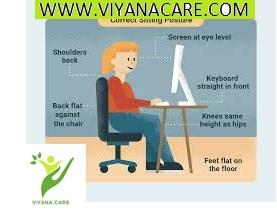Throughout the day, how often do you think about your posture?
If the answer is rarely, it may be time for you and your employees to get a lesson on posture disorder in the workplace.
Research from Harvard University and other institutes show poor posture can cause conditions ranging from fatigue to heartburn. Not only that, it can lead to chronic back pain and neck tightness. Whether you’re sitting at a table, playing on your phone, or working at your computer, good posture is a must for good health and productivity.

WHAT EFFECT DOES BAD POSTURE HAVE?
Aside from overall pain and discomfort, bad posture can lead to multiple health and psychological issues.
The most obvious negative physical side effect of bad posture while at work is soreness and pain in the back and shoulders. By holding your body in this unnatural position, it puts excess strain and tension on these areas.
Slouching can also affect your pelvis. In particular, those who slouch often have issues with pelvic floor dysfunction, which later leads to urinary retention, pain during intercourse, and constipation.

Similarly, poor posture can severely impact your digestive health. Stomach issues like acid reflux and heartburn can occur when slouched, as it means your abdomen is compressed and cannot do its job properly.
Slouching all day while you work means you’re decreasing your flexibility and limiting your range of motion in your neck and back.
A special kind of headache is caused by poor posture: cervicogenic headaches. They originate from pain in the neck and strain on the joints. If you start to have more headaches at the base of your head, posture could be the culprit.

Bad posture even leaks into your self-confidence. Have you ever heard of power poses? Studies show that performing a power pose for several seconds before having to make a major decision, give a presentation, or do something stressful can increase a person’s level of confidence. When you slouch, you do the opposite of a power pose, meaning your self-esteem could be taking a major hit.
TIPS FOR IMPROVING BAD POSTURE AT WORK
After reviewing these negative side effects, you’re likely wondering what you can do to avoid them and improve your posture at work. We’ve got you covered with these tips from our sport expert .

HOW SHOULD YOU BE SITTING?
Start off by sitting at the end of your chair and slouch completely. Next, draw yourself up and lean into the curve of your back as far as possible. Then lean forward again just at about 10 degrees. That’s the position you should aim for.
A good rule of thumb is to keep your ears in line with your shoulders. Don’t lean too far forward or too far backward.
Your bottom should always be touching the back of your chair.
Don’t cross your legs. Keep your feet flat on the floor.
If possible, avoid sitting in the same position for 30 minutes. Getting up and stretching each half-hour is a great way to keep your posture in check.
Distribute your weight evenly at both hips.
Your spine shouldn’t be totally straight. Your lower back should be slightly curved as should your neck.
Position your work and your desk so that you can sit as close as possible and have your computers tilted up to you.
Remember to relax your shoulders from time to time. It’s easier to do this if you have your arms and elbows resting on your desk or chair arms.

We may not notice how we aggravate these postural issues when we spend most of our time sitting in one position, and many of us don’t take enough time each day to rebalance with stretches and strengthening exercises. Our bodies want to work as efficiently as possible, and when we are sedentary for long periods of time, our muscles relax to exert less energy, giving way to gravity
Over time, these issues can become more exaggerated, causing chronic pain, and when we go long enough without corrective measures, we can experience permanent, long-lasting issues.
An easy test to identify the issues in your own body is to have a coworker or friend record you as you walk in a straight line. Walk up and down a line several times to prevent yourself from self-correcting during the diagnostic so you can see what your normal gait is. Watch the recording and see if you notice any of these postural issues.
If you’re noticing bad posture symptoms in more of your employees, it may be time to bring in a health care expert.
At The viyanacare, our team of experienced, enthusiastic and highly qualified has worked with numerous professional sports athletes and recreational sport lovers. We will be happy to assess your Diagnosis Of Occupation Disorder, provide advice on useful exercises to adjust anything that sits outside the normal range.
If the answer is rarely, it may be time for you and your employees to get a lesson on posture disorder in the workplace.
Research from Harvard University and other institutes show poor posture can cause conditions ranging from fatigue to heartburn. Not only that, it can lead to chronic back pain and neck tightness. Whether you’re sitting at a table, playing on your phone, or working at your computer, good posture is a must for good health and productivity.

WHAT EFFECT DOES BAD POSTURE HAVE?
Aside from overall pain and discomfort, bad posture can lead to multiple health and psychological issues.
The most obvious negative physical side effect of bad posture while at work is soreness and pain in the back and shoulders. By holding your body in this unnatural position, it puts excess strain and tension on these areas.
Slouching can also affect your pelvis. In particular, those who slouch often have issues with pelvic floor dysfunction, which later leads to urinary retention, pain during intercourse, and constipation.

Similarly, poor posture can severely impact your digestive health. Stomach issues like acid reflux and heartburn can occur when slouched, as it means your abdomen is compressed and cannot do its job properly.
Slouching all day while you work means you’re decreasing your flexibility and limiting your range of motion in your neck and back.
A special kind of headache is caused by poor posture: cervicogenic headaches. They originate from pain in the neck and strain on the joints. If you start to have more headaches at the base of your head, posture could be the culprit.

Bad posture even leaks into your self-confidence. Have you ever heard of power poses? Studies show that performing a power pose for several seconds before having to make a major decision, give a presentation, or do something stressful can increase a person’s level of confidence. When you slouch, you do the opposite of a power pose, meaning your self-esteem could be taking a major hit.
TIPS FOR IMPROVING BAD POSTURE AT WORK
After reviewing these negative side effects, you’re likely wondering what you can do to avoid them and improve your posture at work. We’ve got you covered with these tips from our sport expert .

HOW SHOULD YOU BE SITTING?
Start off by sitting at the end of your chair and slouch completely. Next, draw yourself up and lean into the curve of your back as far as possible. Then lean forward again just at about 10 degrees. That’s the position you should aim for.
A good rule of thumb is to keep your ears in line with your shoulders. Don’t lean too far forward or too far backward.
Your bottom should always be touching the back of your chair.
Don’t cross your legs. Keep your feet flat on the floor.
If possible, avoid sitting in the same position for 30 minutes. Getting up and stretching each half-hour is a great way to keep your posture in check.
Distribute your weight evenly at both hips.
Your spine shouldn’t be totally straight. Your lower back should be slightly curved as should your neck.
Position your work and your desk so that you can sit as close as possible and have your computers tilted up to you.
Remember to relax your shoulders from time to time. It’s easier to do this if you have your arms and elbows resting on your desk or chair arms.

We may not notice how we aggravate these postural issues when we spend most of our time sitting in one position, and many of us don’t take enough time each day to rebalance with stretches and strengthening exercises. Our bodies want to work as efficiently as possible, and when we are sedentary for long periods of time, our muscles relax to exert less energy, giving way to gravity
Over time, these issues can become more exaggerated, causing chronic pain, and when we go long enough without corrective measures, we can experience permanent, long-lasting issues.
An easy test to identify the issues in your own body is to have a coworker or friend record you as you walk in a straight line. Walk up and down a line several times to prevent yourself from self-correcting during the diagnostic so you can see what your normal gait is. Watch the recording and see if you notice any of these postural issues.
If you’re noticing bad posture symptoms in more of your employees, it may be time to bring in a health care expert.
At The viyanacare, our team of experienced, enthusiastic and highly qualified has worked with numerous professional sports athletes and recreational sport lovers. We will be happy to assess your Diagnosis Of Occupation Disorder, provide advice on useful exercises to adjust anything that sits outside the normal range.
